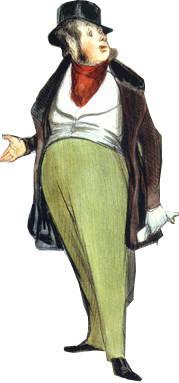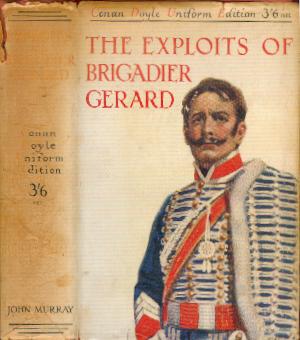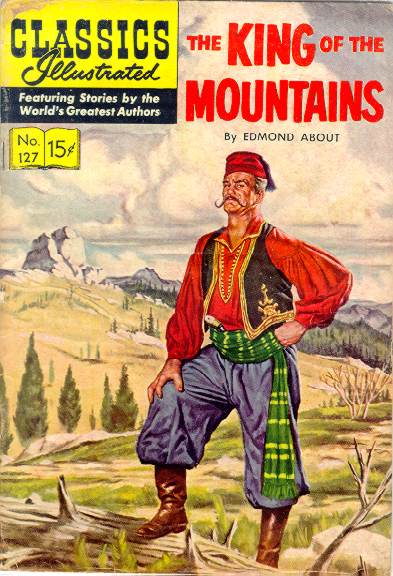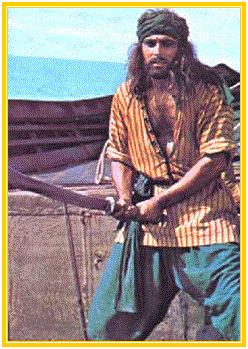The European Wold Newton Universe
Timeline
(1801-1859)
 c. 1801-1823. The rogue, scoundrel, and ne'er-do-well Robert
Macaire carries a series of scams and thefts across France, fraudulently
swindling businesses out of insurence money and succeeding and failing
at thefts great and small. He and his partner in crime, Jacques Strop,
are jailed, but after a short while escape. They stop at a provincial inn,
where Macaire accidentally meets the wife he abandoned and the son he never
knew. Macaire is killed while trying to escape from the soldiers
dispatched to capture him. (Benjamin Antier's L'Auberge des Adrets,
1823, and Frederick Lemaître's Robert Macaire, 1834).
c. 1801-1823. The rogue, scoundrel, and ne'er-do-well Robert
Macaire carries a series of scams and thefts across France, fraudulently
swindling businesses out of insurence money and succeeding and failing
at thefts great and small. He and his partner in crime, Jacques Strop,
are jailed, but after a short while escape. They stop at a provincial inn,
where Macaire accidentally meets the wife he abandoned and the son he never
knew. Macaire is killed while trying to escape from the soldiers
dispatched to capture him. (Benjamin Antier's L'Auberge des Adrets,
1823, and Frederick Lemaître's Robert Macaire, 1834).
1805. An innocent German college student, Nathanael, is driven
insane through his involvement (first as a child, then as a young man)
in one of the schemes of "Dr. Coppelius," a.k.a. Cagliostro. Cagliostro,
posing first as Coppelius and later as "Coppola," creates an android,
"Olimpia," who unbalances Nathanael and finally causes him to commit suicide.
(E.T.A. Hoffmann's "Der Sandmann," 1817). Why Cagliostro (thanks to Dr.
Lofficier's information, now better known as Joseph Balsamo) would
have bothered with a non-entity like Nathanael is unknown--unless one takes
into account the present of the android, Olimpia, who is a crude creation
with a very limited vocabulary. Perhaps Nathanael was only a test subject
for a scheme that history has so far not discovered? (If so, the scheme
failed. Nicholaus Geibel's android "Lieutenant Fritz" was no more
advanced than Olimpia (see below)).
1806. The Spaniard Don Diego Vega begins adventuring as Zorro.
(Johnston McCulley's Zorro stories, beginning with "The Curse of Capistrano,"
1919).
 1807-1821. Étienne Gerard leads a life of adventure and
honor in the service of Napoleon. As a member of the Emperor's 10th Hussars,
Brigadier Gerard gets many chances to back up his boasts about the
quality of his swordsmanship and horsemanship. Gerard fights any number of
duels, carries out several of the Emperor’s intrigues, escapes from Dartmoor
prison and the clutches of a ruthless Spanish bandit, captures Saragossa
single handedly, woos any number of women, befriends English officers,
and in general has a fine old time in Europe and Russia. (Arthur Conan Doyle's
Brigadier Gerard stories, beginning with "How the Brigadier Won His Metal,"
1894).
1807-1821. Étienne Gerard leads a life of adventure and
honor in the service of Napoleon. As a member of the Emperor's 10th Hussars,
Brigadier Gerard gets many chances to back up his boasts about the
quality of his swordsmanship and horsemanship. Gerard fights any number of
duels, carries out several of the Emperor’s intrigues, escapes from Dartmoor
prison and the clutches of a ruthless Spanish bandit, captures Saragossa
single handedly, woos any number of women, befriends English officers,
and in general has a fine old time in Europe and Russia. (Arthur Conan Doyle's
Brigadier Gerard stories, beginning with "How the Brigadier Won His Metal,"
1894).
1816. Emil St. George is a Frenchman whose brother, a General
under Napoleon, was killed by the Prussians while a prisoner. St. George
himself was decorated by Napoleon on the morning of Waterloo. But Napoleon
lost and was exiled, and St. George was left embittered because of the loss
and with a burning hatred for all Prussians because of the ignoble way
in which his father was killed. So Emil enrolls in the University at Heidelberg.
This being Heidelberg, dueling is all the rage. Emil takes a particular
pleasure in provoking quarrels with the Prussian students, and these quarrels
always result in duels, which Emil insists on fighting a l’outrance
(using sharp weapons and no armor) rather than in armor. Emil always kills
his opponent, rather than just scarring him, as is the custom. Emil fights
at least one duel a week, sometimes against four or more men in a row,
and during these duels not only kills his opponent but displays a terrifying
skill with the short sword and saber. It is because of his bloodthirstiness,
and the evil smile across his face as he fights, that he is known at school
as the “Demon Duelist.” At the same time Emil is leading a gang
of bandits--veterans of Napoleon’s Grande Armée--in rampages
across the German countryside. Eventually Emil has his heartbroken at the
death of a Prussian woman and rejoins the French military, dying in the
Franco-Prussian War of 1870. (Colonel Thomas Hoyer Monstery's “The Demon
Duelist,” 1881).
1828. The German Count Axël d’Auersberg unsuccessfully
struggles with material temptation. He fails, committing suicide and greatly
disappointing his Rosicrucian mentor Master Janus. (Villiers de l’Isle
Adam's Axël, 1872).
The German magistrate Mr. von L----- is called upon to solve
the puzzling mystery of a murder, despite the apparent murderer being
willing to confess to the crime. Mr. von L----- succeeds in convincing
the murderer that it was a bandit who pulled the trigger. (Adolph Müllner's
“Der Kaliber,” 1828).
1830-1838. The reformed faux-monnoyer M. Favart
rises in the ranks of the police in Paris and is regarded as “one of the
most renowned chiefs of the great Parisian police, a man worthy to be the
contemporary of the illustrious Vidocq.” Favart is killed while attempting
to break up a ring of counterfeiters. (Edward George Bulwer-Lytton's Night
and Morning, 1841).
 1833-1856. With the end of the Greek War of Independence Hadji
Stavros finds himself out of work. During the war he was a patriotic
priate, fighting against the Turks both on land and on sea. He became an
international hero because of this; Byron dedicated an ode to him, Parisian
poets compared him to the heroes of the classics, and citizen organizations
in France, England and Russia sent him money to continue the fight against
the Turks. But when the war ended Stavros ran into difficulties, because
he was unwilling to pay taxes for the money he had been given. So he continued
his banditry, this time focusing on travelers. His success attracted others
to him, and by 1850 he was the leader of an enormous gang of cutthroats who
obey him completely and without question. Stavros is a jolly, conscienceless
murderer who is willing to commit small crimes as well as large ones, as
long as he profits from them. His men spend their money foolishly, but Stavros
invests his money wisely, so that when the Greek Army finally destroys
his gang, Stavros simply retires, enjoys his profits, and contemplates becoming
the Greek government's Minister of Justice. (Edmond About's Le Roi des
Montagnes, 1857). (The similarity between Stavros and Don Q
(see below) is intriguing, but there is no proof of any relationship between
them).
1833-1856. With the end of the Greek War of Independence Hadji
Stavros finds himself out of work. During the war he was a patriotic
priate, fighting against the Turks both on land and on sea. He became an
international hero because of this; Byron dedicated an ode to him, Parisian
poets compared him to the heroes of the classics, and citizen organizations
in France, England and Russia sent him money to continue the fight against
the Turks. But when the war ended Stavros ran into difficulties, because
he was unwilling to pay taxes for the money he had been given. So he continued
his banditry, this time focusing on travelers. His success attracted others
to him, and by 1850 he was the leader of an enormous gang of cutthroats who
obey him completely and without question. Stavros is a jolly, conscienceless
murderer who is willing to commit small crimes as well as large ones, as
long as he profits from them. His men spend their money foolishly, but Stavros
invests his money wisely, so that when the Greek Army finally destroys
his gang, Stavros simply retires, enjoys his profits, and contemplates becoming
the Greek government's Minister of Justice. (Edmond About's Le Roi des
Montagnes, 1857). (The similarity between Stavros and Don Q
(see below) is intriguing, but there is no proof of any relationship between
them).
 1836. An old bronze statue of Venus is unearthed in the town of
Ille, in the French Pyrenees. A local antiquarian is taken with it and
installs it in his house. The statue is striking, but also unnerving, for
"disdain, irony, cruelty, could be distinguished in that face which was,
notwithstanding, of incredible beauty. Indeed, the longer one looked at
that wonderful statue, the more distress one felt at the thought that such
a marvelous beauty could be united with an utter absence of goodness." Unfortunately,
the antiquarian's son makes the mistake of putting his wedding ring on
the statue's hand. The hand closes on the ring and will not release it,
and that night the antiquarian's son is crushed in his bed. The statue is
later melted down and made into church bells, but their ringing brings death
to the local vines. (Prosper Mérimée's “La Venus d'Ille,” 1837).
1836. An old bronze statue of Venus is unearthed in the town of
Ille, in the French Pyrenees. A local antiquarian is taken with it and
installs it in his house. The statue is striking, but also unnerving, for
"disdain, irony, cruelty, could be distinguished in that face which was,
notwithstanding, of incredible beauty. Indeed, the longer one looked at
that wonderful statue, the more distress one felt at the thought that such
a marvelous beauty could be united with an utter absence of goodness." Unfortunately,
the antiquarian's son makes the mistake of putting his wedding ring on
the statue's hand. The hand closes on the ring and will not release it,
and that night the antiquarian's son is crushed in his bed. The statue is
later melted down and made into church bells, but their ringing brings death
to the local vines. (Prosper Mérimée's “La Venus d'Ille,” 1837).
1840. A German nobleman, Baron von S-----, helps solve
a decades-old murder. (Annette von Droste-Hülshoff's Die Judenbuche,
1842).
1841. A reclusive, impoverished French nobleman, the Chevalier
C. Auguste Dupin, solves his first notable murder case. (Edgar Allan
Poe's "The Murders in the Rue Morgue," 1841).
 1841-1868. Sandokan is the son of the former rajah of a
nameless, prosperous Malaysian state. When Sandokan's father and family
are attacked and slaughtered, their guards, who are the personal guards
of James Brooke, the English Governor of the island of Labuan, do nothing.
Sandokan goes to live with his faithful old teacher, but after dreaming
of the deaths of his family resolves to search out Brooke and find out why
Brooke betrayed Sandokan's father. Sandokan takes to sea as a ship's boy
on a steamer bound for Labuan. Sandokan and his best friend Janez, a Portuguese
wanderer, escape from a trap set by Brooke and set ashore on Mompracem,
an island that later becomes their hideout. They first have to capture it
from a band of pirates, who are so impressed by the courage of Sandokan
and Janez that they join them, becoming “the young tigers of Malaysia.”
1841-1868. Sandokan is the son of the former rajah of a
nameless, prosperous Malaysian state. When Sandokan's father and family
are attacked and slaughtered, their guards, who are the personal guards
of James Brooke, the English Governor of the island of Labuan, do nothing.
Sandokan goes to live with his faithful old teacher, but after dreaming
of the deaths of his family resolves to search out Brooke and find out why
Brooke betrayed Sandokan's father. Sandokan takes to sea as a ship's boy
on a steamer bound for Labuan. Sandokan and his best friend Janez, a Portuguese
wanderer, escape from a trap set by Brooke and set ashore on Mompracem,
an island that later becomes their hideout. They first have to capture it
from a band of pirates, who are so impressed by the courage of Sandokan
and Janez that they join them, becoming “the young tigers of Malaysia.”
Sandokan begins a Robin Hood-like life of piracy, picking up a girlfriend,
Marianna, along the way. That Marianna is James Brooke's niece does not,
in the end, threaten their relationship, for they get married after he
proposes to her with a gift of extremely opulent rubies. After fighting
Thugs (in the dreaded Black Jungle of India), sorcerers, the English, the
jungles of Malaysia, Honorata (the descendant of Circe) the slopes of the
Himalayas, and various lost peoples, and after restoring at least one deposed
princess of Assam to her throne, Sandokan defeats Brooke and his flunkies
and regains the kingdom taken from his father. (Emilio Salgari's Sandokan
novels, beginning with La Tigre della Malesia, 1883-1884).
Sandokan's defeat of the Thugs of the Black Jungle was unfortunately
not permanent. They still existed in the 20th century and were fought
by John Mauri and Rama Sahib, among others (see below).
1850-1859. An unnamed Italian secret society dispatches Isidor
Ottavio Baldassare Fosco, later known as "Count Fosco," to England,
“charged with a delicate political mission.” Fosco rises in English society
but is eventually undone by a very clever English woman. (Wilkie Collins'
The Woman in White, 1859-1860). This secret society is only known
as "the Brotherhood;" it is unknown if it had ties to the Black Coats.
c. 1850-c. 1860. A Parisian man, bored with life in the city,
emigrates to America and discovers his greatest talents. Valentine
Guillois wanders around the American frontier as a kind of übermensch,
fighting for his principles, helping the poor and oppressed, and having
a wide range of exciting adventures. Guillois fights savage Indians, crude,
pious, hypocritical and greedy Yankees, and vicious Mexicans. The only
thing that makes the frontier bearable for Guillois is the presence of
his fellow Frenchmen and women, who create little enclaves of French culture
across the wide frontier of America. ("Gustav Aimard"/Oliver Gloux's Valentine
Guillois novels, possibly beginning with Les Pirates des Plains,
1858). (But see note #5 on the Notes page).
c. 1850-1865. A pair of German men take a warship and, with
a crew of like-minded sailors, patrol the Atlantic, capturing slave ships,
releasing the slaves to freedom in Africa, and seeing to the punishment
of the American slavers. The Germans become known as the Slave Deliverers.
(Die Sklavenbefreier #1-18, 1921).
c. 1850-1880. Captain Fred Stürmer, on his ship
the Albatross, sails around the world and has various adventures.
He is known as Stürm Vogel, the "Storm Bird," but is well-known
and well-loved wherever he goes. (Kapitän Stürmer Fahrten
und Abenteuer zu Wasser und zu Lande #1-75, 1906-1908).
c. 1855-c. 1865. An older German immigrant gains fame on the
American frontier as the Old Scout. He works for the American army
as a freelance Indian fighter, but also works as a scout for civilian settlers.
Some of his encounters are supernatural, including conflicts with “jaguar
men” and “wizards,” and he ranges widely, from northern Canada to southern
Mexico. (William Taylor’s Der Alte Waldläufer #1-27, 1919-1920).
 c. 1855-c. 1875. The German cowboy Bob Hunter, moved by passionate
feelings of justice and the plight of the less fortunate, begins traveling
across the Americas, doing good whenever he finds that he is needed. With
his native friend Red Ben, Hunter fights such enemies as the Red Pirate,
warlike black Amazons in Brazil, slave owners in Louisiana, Aztecs along
the Rio Puerco, the Man in the Red Turban, the Robin Hood-like King of the
Forests, Comanches warring on settlers in western Canada, and a vicious group
of Molly Maguires. (Bob Hunter auf Indianerpfaden #1-111, 1937-1939).
c. 1855-c. 1875. The German cowboy Bob Hunter, moved by passionate
feelings of justice and the plight of the less fortunate, begins traveling
across the Americas, doing good whenever he finds that he is needed. With
his native friend Red Ben, Hunter fights such enemies as the Red Pirate,
warlike black Amazons in Brazil, slave owners in Louisiana, Aztecs along
the Rio Puerco, the Man in the Red Turban, the Robin Hood-like King of the
Forests, Comanches warring on settlers in western Canada, and a vicious group
of Molly Maguires. (Bob Hunter auf Indianerpfaden #1-111, 1937-1939).
1859. A retired American diplomat, living in Paris, solves a
crime (the theft of a valuable Indian diamond) and foils a conspiracy (to
overthrow the French government). (Harriet Prescott Spofford's "In a Cellar,"
1859). (The identity of this individual remains unknown).
Timeline: To
1800.
Timeline: 1860-1900.
Timeline: 1901-1910.
Timeline: 1911-1920.
Timeline: 1921-1930.
Timeline: 1931-1945.
Notes.
Some Unknown Members
of the Wold Newton Family Tree.
 c. 1801-1823. The rogue, scoundrel, and ne'er-do-well Robert
Macaire carries a series of scams and thefts across France, fraudulently
swindling businesses out of insurence money and succeeding and failing
at thefts great and small. He and his partner in crime, Jacques Strop,
are jailed, but after a short while escape. They stop at a provincial inn,
where Macaire accidentally meets the wife he abandoned and the son he never
knew. Macaire is killed while trying to escape from the soldiers
dispatched to capture him. (Benjamin Antier's L'Auberge des Adrets,
1823, and Frederick Lemaître's Robert Macaire, 1834).
c. 1801-1823. The rogue, scoundrel, and ne'er-do-well Robert
Macaire carries a series of scams and thefts across France, fraudulently
swindling businesses out of insurence money and succeeding and failing
at thefts great and small. He and his partner in crime, Jacques Strop,
are jailed, but after a short while escape. They stop at a provincial inn,
where Macaire accidentally meets the wife he abandoned and the son he never
knew. Macaire is killed while trying to escape from the soldiers
dispatched to capture him. (Benjamin Antier's L'Auberge des Adrets,
1823, and Frederick Lemaître's Robert Macaire, 1834).  1807-1821. Étienne Gerard leads a life of adventure and
honor in the service of Napoleon. As a member of the Emperor's 10th Hussars,
Brigadier Gerard gets many chances to back up his boasts about the
quality of his swordsmanship and horsemanship. Gerard fights any number of
duels, carries out several of the Emperor’s intrigues, escapes from Dartmoor
prison and the clutches of a ruthless Spanish bandit, captures Saragossa
single handedly, woos any number of women, befriends English officers,
and in general has a fine old time in Europe and Russia. (Arthur Conan Doyle's
Brigadier Gerard stories, beginning with "How the Brigadier Won His Metal,"
1894).
1807-1821. Étienne Gerard leads a life of adventure and
honor in the service of Napoleon. As a member of the Emperor's 10th Hussars,
Brigadier Gerard gets many chances to back up his boasts about the
quality of his swordsmanship and horsemanship. Gerard fights any number of
duels, carries out several of the Emperor’s intrigues, escapes from Dartmoor
prison and the clutches of a ruthless Spanish bandit, captures Saragossa
single handedly, woos any number of women, befriends English officers,
and in general has a fine old time in Europe and Russia. (Arthur Conan Doyle's
Brigadier Gerard stories, beginning with "How the Brigadier Won His Metal,"
1894).  1833-1856. With the end of the Greek War of Independence Hadji
Stavros finds himself out of work. During the war he was a patriotic
priate, fighting against the Turks both on land and on sea. He became an
international hero because of this; Byron dedicated an ode to him, Parisian
poets compared him to the heroes of the classics, and citizen organizations
in France, England and Russia sent him money to continue the fight against
the Turks. But when the war ended Stavros ran into difficulties, because
he was unwilling to pay taxes for the money he had been given. So he continued
his banditry, this time focusing on travelers. His success attracted others
to him, and by 1850 he was the leader of an enormous gang of cutthroats who
obey him completely and without question. Stavros is a jolly, conscienceless
murderer who is willing to commit small crimes as well as large ones, as
long as he profits from them. His men spend their money foolishly, but Stavros
invests his money wisely, so that when the Greek Army finally destroys
his gang, Stavros simply retires, enjoys his profits, and contemplates becoming
the Greek government's Minister of Justice. (Edmond About's Le Roi des
Montagnes, 1857). (The similarity between Stavros and Don Q
(see below) is intriguing, but there is no proof of any relationship between
them).
1833-1856. With the end of the Greek War of Independence Hadji
Stavros finds himself out of work. During the war he was a patriotic
priate, fighting against the Turks both on land and on sea. He became an
international hero because of this; Byron dedicated an ode to him, Parisian
poets compared him to the heroes of the classics, and citizen organizations
in France, England and Russia sent him money to continue the fight against
the Turks. But when the war ended Stavros ran into difficulties, because
he was unwilling to pay taxes for the money he had been given. So he continued
his banditry, this time focusing on travelers. His success attracted others
to him, and by 1850 he was the leader of an enormous gang of cutthroats who
obey him completely and without question. Stavros is a jolly, conscienceless
murderer who is willing to commit small crimes as well as large ones, as
long as he profits from them. His men spend their money foolishly, but Stavros
invests his money wisely, so that when the Greek Army finally destroys
his gang, Stavros simply retires, enjoys his profits, and contemplates becoming
the Greek government's Minister of Justice. (Edmond About's Le Roi des
Montagnes, 1857). (The similarity between Stavros and Don Q
(see below) is intriguing, but there is no proof of any relationship between
them).  1836. An old bronze statue of Venus is unearthed in the town of
Ille, in the French Pyrenees. A local antiquarian is taken with it and
installs it in his house. The statue is striking, but also unnerving, for
"disdain, irony, cruelty, could be distinguished in that face which was,
notwithstanding, of incredible beauty. Indeed, the longer one looked at
that wonderful statue, the more distress one felt at the thought that such
a marvelous beauty could be united with an utter absence of goodness." Unfortunately,
the antiquarian's son makes the mistake of putting his wedding ring on
the statue's hand. The hand closes on the ring and will not release it,
and that night the antiquarian's son is crushed in his bed. The statue is
later melted down and made into church bells, but their ringing brings death
to the local vines. (Prosper Mérimée's “La Venus d'Ille,” 1837).
1836. An old bronze statue of Venus is unearthed in the town of
Ille, in the French Pyrenees. A local antiquarian is taken with it and
installs it in his house. The statue is striking, but also unnerving, for
"disdain, irony, cruelty, could be distinguished in that face which was,
notwithstanding, of incredible beauty. Indeed, the longer one looked at
that wonderful statue, the more distress one felt at the thought that such
a marvelous beauty could be united with an utter absence of goodness." Unfortunately,
the antiquarian's son makes the mistake of putting his wedding ring on
the statue's hand. The hand closes on the ring and will not release it,
and that night the antiquarian's son is crushed in his bed. The statue is
later melted down and made into church bells, but their ringing brings death
to the local vines. (Prosper Mérimée's “La Venus d'Ille,” 1837).
 1841-1868. Sandokan is the son of the former rajah of a
nameless, prosperous Malaysian state. When Sandokan's father and family
are attacked and slaughtered, their guards, who are the personal guards
of James Brooke, the English Governor of the island of Labuan, do nothing.
Sandokan goes to live with his faithful old teacher, but after dreaming
of the deaths of his family resolves to search out Brooke and find out why
Brooke betrayed Sandokan's father. Sandokan takes to sea as a ship's boy
on a steamer bound for Labuan. Sandokan and his best friend Janez, a Portuguese
wanderer, escape from a trap set by Brooke and set ashore on Mompracem,
an island that later becomes their hideout. They first have to capture it
from a band of pirates, who are so impressed by the courage of Sandokan
and Janez that they join them, becoming “the young tigers of Malaysia.”
1841-1868. Sandokan is the son of the former rajah of a
nameless, prosperous Malaysian state. When Sandokan's father and family
are attacked and slaughtered, their guards, who are the personal guards
of James Brooke, the English Governor of the island of Labuan, do nothing.
Sandokan goes to live with his faithful old teacher, but after dreaming
of the deaths of his family resolves to search out Brooke and find out why
Brooke betrayed Sandokan's father. Sandokan takes to sea as a ship's boy
on a steamer bound for Labuan. Sandokan and his best friend Janez, a Portuguese
wanderer, escape from a trap set by Brooke and set ashore on Mompracem,
an island that later becomes their hideout. They first have to capture it
from a band of pirates, who are so impressed by the courage of Sandokan
and Janez that they join them, becoming “the young tigers of Malaysia.” c. 1855-c. 1875. The German cowboy Bob Hunter, moved by passionate
feelings of justice and the plight of the less fortunate, begins traveling
across the Americas, doing good whenever he finds that he is needed. With
his native friend Red Ben, Hunter fights such enemies as the Red Pirate,
warlike black Amazons in Brazil, slave owners in Louisiana, Aztecs along
the Rio Puerco, the Man in the Red Turban, the Robin Hood-like King of the
Forests, Comanches warring on settlers in western Canada, and a vicious group
of Molly Maguires. (Bob Hunter auf Indianerpfaden #1-111, 1937-1939).
c. 1855-c. 1875. The German cowboy Bob Hunter, moved by passionate
feelings of justice and the plight of the less fortunate, begins traveling
across the Americas, doing good whenever he finds that he is needed. With
his native friend Red Ben, Hunter fights such enemies as the Red Pirate,
warlike black Amazons in Brazil, slave owners in Louisiana, Aztecs along
the Rio Puerco, the Man in the Red Turban, the Robin Hood-like King of the
Forests, Comanches warring on settlers in western Canada, and a vicious group
of Molly Maguires. (Bob Hunter auf Indianerpfaden #1-111, 1937-1939).